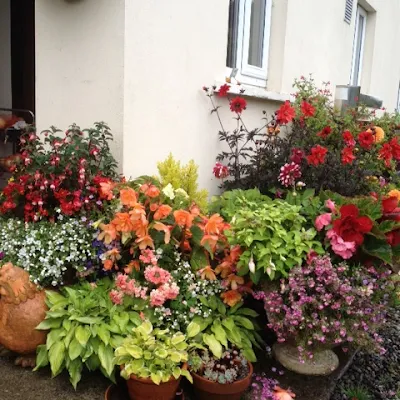 |
| Dahlia 'Berwick Wood' in the Botanic Gardens |
 |
 |
| Dahlia 'Ludwig Helfert' |
 |
| Dahlia 'Janal Army' |
My own preference is for Dahlia plants that grow above knee height, and have their flowers well above foliage height, in order for viewers to really get the best out of them. Some varieties have the flowers hidden, or partially hidden, by the foliage, which is of little benefit.
 |
| Dahlia ' Taratahi Ruby' |
During the summer, I have included Dahlia's in some of the plant talks or discussions I've had, talking about the benefits of growing them, the care needed and of course how to regrow them year after year. I continue to be surprised by people that will purchase them as plants, rather than tubers, and then decline to make any effort to overwinter the plants, preferring instead to let them them take their chances and if they re-grow, that 's fine, and if they don't - well, more will be purchased...
 |
| Dahlia 'Kenora Challenger' |
So, for my part I do try to convey how, with a little effort, the easiness of growing these very rewarding plants are to:
 |
| Dahlia 'Bracken Ballerina' |
In the spring, probable March, bring out (or purchase some) Dahlia tubers.
Place these tubers into pots of good compost (I used crates this year), covering them so only the tip of the stem is left exposed.
Water the pot and place it into a greenhouse, coldframe or even onto a bright windowsill.
 |
| Dahlia 'Juliet' |
After about 4-6 weeks, young shoots will appear. it is crucial at this point to ensure these are protected from slugs and snails - which absolutely love them !
Once we approach the end of May, when chances of frost are slim, we can begin hardening off the plants and then plant them into borders, containers, etc.
 |
| Dahlia 'Clair de Lune' |
Dead-head, protect from slugs and snails and feed.
Most importantly though - enjoy, enjoy and enjoy.
 |
| Dahlia 'Bishop of Llandaff' |
Once Autumn comes around, just before the first frosts, lift the tubers, remove most of the foliage and allow them to almost dry out in a shed or garage.
Once we get into late November, I remove most of the remaining compost and store the tubers in a very sandy, slightly moist, medium - in a frost free shed or store.
 |
| Dahlia 'Evelyn' |
And then in the spring, the cycle starts again.
 |
| Dahlia 'Duet' |
Even as I'm writing these steps, to the uninitiated it sounds like a lot of work, but honestly it isn't, and for the little work you put in, you are rewarded with flowers and colour from July, right through to first frosts.
As I mentioned above, I used crates, lining them with newspaper and then filling with plenty of good quality compost to start the tubers off in. The idea was to grow blocks of colour that I could move into my shrub and flower borders to give late summer interest. As it turns out, I haven't moved them from where I hardened them off, as the colour and impact they have where they are has been fantastic - this is something I'm going to do again next year.
 |
| Dahlia's (to the right) adding great impact to my colour display |
Happy gardening.
Beautiful and inspiring flowers.. make me smile when I look at them.. thanks for sharing:)
ReplyDeleteA Grow bag manufacturers in India is a container made from fabric or plastic, used for cultivating plants, especially in small or urban spaces. It promotes better root aeration and drainage compared to traditional pots. Ideal for growing vegetables, herbs, and flowers, grow bags are lightweight, reusable, and space-efficient, making them popular for home gardening and commercial horticulture.
ReplyDeleteCool
ReplyDelete